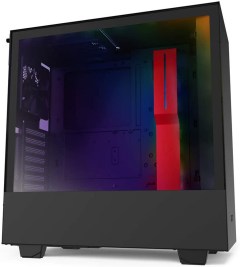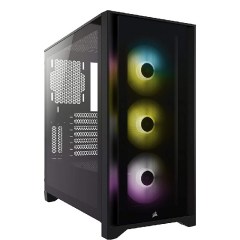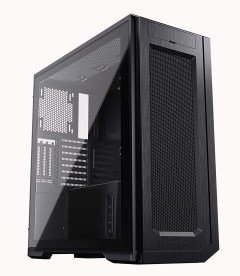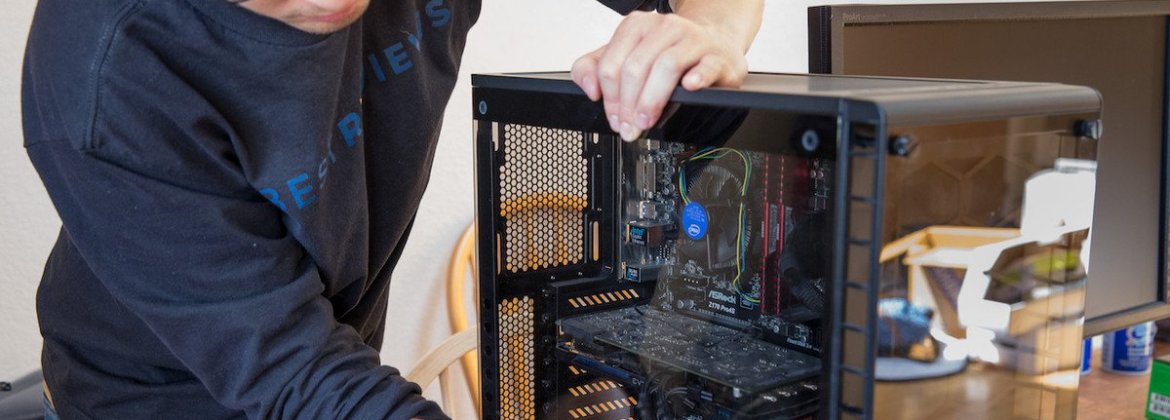
This model is well made with a look customers love and an impressive cable management system.
This model is well made with a look customers love and an impressive cable management system.
Built-in smart technology that controls RGB LED lighting and fans. The sleek tempered glass panel is stylish. Nice cable management system. Durable, roomy build. Has USB type C connections.
Some quirks with the CAM software have been reported. Airflow may not be adequate.

All 3 ARGB fans make this case a vibrant way to cool your gaming setup while you play
All 3 ARGB fans make this case a vibrant way to cool your gaming setup while you play
The tempered glass side panel is a sturdy but transparent way to see your computer in action and keep things easy to tinker with. The grid front panel dissipates heat and looks good while doing it.
Some people thought this case was too cramped for their setup.

A colorful, custom-lit case with tempered glass sides that keeps your setup running smoothly.
A colorful, custom-lit case with tempered glass sides that keeps your setup running smoothly.
Includes 3 120mm AirGuide RGB fans with custom lighting so you take control of the case's aesthetic. The RapidRoute cable management system keeps your components well organized and secure.
It's cramped inside. Some gamers lament its sub-par cooling capabilities.

Worth a look if you're looking for a case with decent features and a price that falls on the lower end.
Worth a look if you're looking for a case with decent features and a price that falls on the lower end.
The magnetic dust cover filters are easy to remove and put back. Rounded edges and a well-made acrylic panel. Not too tall, making it ideal for areas with limited space. Effective ventilation. Affordable price.
The cable management system is lacking and needs cutouts. Lack of ample interior space.

Perfect for creating a neat build thanks to good cable management and a strong front I/O.
Perfect for creating a neat build thanks to good cable management and a strong front I/O.
The interior works great for any build and the front I/O is stacked with ports. The cable management capabilities in this case are strong thanks to various indents that can guide cables away. Strong thermal performance.
Fairly large.

We recommend these products based on an intensive research process that's designed to cut through the noise and find the top products in this space. Guided by experts, we spend hours looking into the factors that matter, to bring you these selections.

Updated January 2025
If you’re building your own PC, you’ll need to spend some time picking out the perfect components. One of the most important, and oft-overlooked, parts to select is the computer case. Your computer case will be the foundation of your machine, and it needs to have the right amount of layout and storage space.
Computer cases come in all shapes, sizes, and colors — and varying levels of quality, too. The case you buy needs to have enough room for everything from your motherboard to your hard drives (and a system for ventilating air for keeping it all cool). And if you ask most PC builders, it should reflect your personal style, too: computer cases come in all kinds of funky designs, so there’s definitely an opportunity to express your tastes through your case.
Whether you’re looking for a basic computer case for the family computer or a home for your next PC gaming rig, we’ve got you covered. Here’s everything you need to find your perfect computer case.

Before you start shopping, spend some time considering your specific needs. Start with these questions.
As you compare computer cases, watch for these features; they’re the ones that set the really great models apart from the rest.
We’re big fans of computer cases that come with fans already installed. The fans are set up with a specific design for airflow, and all you have to do is plug them in to the right power connection. You could buy a case without them and then find and install fans that fit, but depending on which fans you buy, that could drive up the cost significantly.
Although it’s strictly cosmetic, LED lighting in a computer case is still a ton of fun. Some cases even include lighting that can be controlled with software, so you can come up with your own lighting schemes (like matching the LED colors to the game you’re playing or the show you’re watching).
Many computer cases include front panels that offer easy access to USB and headphone ports. It might not sound like a big deal, but the convenience is really worth it, especially if you need to quickly attach peripheral like USB flash drives.
Entry-level computer cases cost between $40 and $80. Models in this price range often only support the smaller mATX motherboard standard, or they don’t include room for much more than the basics. If you’re building your first PC or don’t plan on upgrading or expanding anytime soon, you can find decent options in this range.
The best values in computer cases are typically between $80 and $140. Cases in this price range are spacious, offering premium features like modular designs or built-in cable management systems. If you have intense storage needs or are a serious gamer, you’ll probably want to look at more expensive cases. If you just need a case that’s got a reasonable mix of space, flexibility, and ventilation, there are plenty of options for less than $140.
Luxury PC cases start at $140 and go up from there. Cases in this price range are either enormous (with enough room for a ton of hard drives) or made from premium finishes. If you’re building a home theater PC or just want a case that looks more James Bond than Star Trek, expect to pay top dollar.
If you’re building a home theater PC, we recommend the living room-friendly Silverstone HTPC case. It’s a horizontal case that’s designed to be right at home with high-end AV electronics while still providing proper ventilation. It’s got front-facing USB and audio ports, and it’s even got enough room for an optical drive. If you need one of the best-looking cases around, keep this one on your shortlist.
For small-form factor computers, we recommend you consider the Thermaltake Core V21. At roughly 17 x 13 x 13 inches, it’s bigger than a breadbox, but only slightly. The grated metal design gives the case a futuristic feel while offering an added level of ventilation, which is key in cases this small. If you’re building a computer with an mATX board, this case is one of your best options.

Q. What’s the best way to keep cables organized inside my PC case?
A. It will vary based on your individual computer case, but in general, zip ties are the best way to keep cables cleaned up and out of the way. Some cases even have special slots just for using zip ties, so make a plan for where you’ll use each one before you start installing components in the case.
Q. Is it safe to buy a horizontal computer case instead of a traditional vertical one?
A.Yes. Some computer cases are built to mimic AV components like your cable set top box. As long as there’s proper airflow in the case, there’s no benefit to one over the other.
Q. Will I need any special tools to install my PC components in a computer case?
A. Not usually. Most computer parts get installed with a standard Phillips head screwdriver or will use thumb screws.
Get emails you’ll love.
Learn about the products you’re wondering if you should buy and get advice on using your latest purchases.
